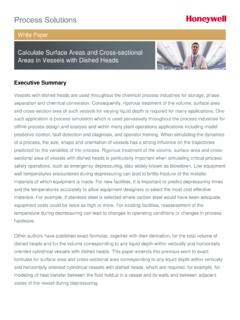Transcription of Universal Digital Controller Specification
1 UDC2500 Universal Digital Controller 51-52-03-36 January 2009 Page 1 of 14 SpecificationOverview The UDC2500 Universal Digital Controller is a new, low-priced addition to Honeywell s Controller family. This Controller introduces new features in the popular low priced DIN size while retaining all the reliability, cost effectiveness, simplicity, and popular HMI of Honeywell s UDC 2300. The UDC2500 monitors and controls temperatures and other variables in applications such as: furnaces and ovens, environmental chambers, packaging machinery, plastic processing machines. Features 1 Universal Input + 1 high level input Accuracy Fast scanning rate (166ms) Up to 5 Analog or Digital Output Types Figure 1 Front of UDC2500 2 Digital Inputs Ethernet and Modbus communication Infrared PC & Pocket PC configuration NEMA4X and IP66 front face protection Multilanguage prompts DIN Size Jumper free configuration Easily Field Upgradable Downward compatibility with existing UDC2300 applications Limit model The standard features include Accutune III and the popular single display, automatic mode model.
2 A Dual Display model with Automatic/Manual control modes is optional. A Limit Control model is also available. The UDC2500 provides a DIN sized alternative for many applications. Its features include: Universal AC power supply, optional RS422/485 Modbus RTU or Ethernet 10 Base-T TCP/IP communication protocols, input/output isolation, Isolated Auxiliary Current output. When these are combined with the Accutune III tuning with fuzzy logic overshoot suppression, the result is price/performance leadership. Configuration can be done with a PC through communication or with a Pocket PC, using the embedded infra red communication port. No need to get access to the back of the Controller to download or upload a brand new configuration!
3 For the many thousands of satisfied UDC2300 users, the UDC2500 is downward-compatible with most existing UDC2300 applications. Analog Inputs The UDC2500 has two analog inputs with a typical accuracy of of full-scale input and a typical resolution of 16 bits. Both analog inputs are sampled six times per second (every 166 ms). The first input is a low-level type which accepts thermocouple, RTD, ma, mV, and voltage types (See Table 1 on page 10.). The second input is a high level type and can be used as a remote setpoint, for data acquisition or as a parameter to be alarmed on. This input accepts ranges 0-5V, 1-5V, 0-2V, 0-20mA or 4-20mA. Cold junction compensation is provided for thermocouple type inputs. Upscale or downscale sensor break protection is keyboard configurable.
4 A configurable Digital filter of 0 to 120 seconds provides input signal damping. All input types are configurable via the keyboard, there are no internal jumpers or switches. The two inputs are isolated from all other inputs and outputs, but not from each other. Thermocouple Health - In addition to the standard configurable upscale, downscale or failsafe output burnout selections, the condition of the thermocouple can be monitored to determine if it is good, failing or in danger of imminent failure. 51-52-03-36 Page 2 Digital Inputs Two isolated Digital inputs are provided for remote dry contact closure to select one of the following actions : Manual control mode. Local setpoint 1 or Local setpoint 2. Direct Controller action.
5 Hold SP Ramp/Program. Select PID set 2. Run - SP Ramp/Program. External program reset. Disable PID integral action. Manual mode, failsafe output. Disable keyboard. Start Timer. Initiate Tuning. Initiate PV Hot Start Output tracks Input 2. To Remote Setpoint. To Latching Manual Mode. Also, the Digital inputs can allow one of the following selections to be combined with one of the above selections: Select PID set 2. Direct Controller action. Local setpoint 2 or Local setpoint 1. To Run. The 2nd Current Output and the 2nd Digital Input are mutually exclusive. Selection is made via a keyboard entry. Outputs and Control Five Outputs - The following output types are available: Current Outputs (4-20 or 0- 20 ma ) Electromechanical Relays (5 amps) Solid State Relays (1 amp) Dual Electromechanical Relays (2 amps) Open Collector Outputs Output Algorithms - The UDC2500 is available with one or more of the following output algorithms: Time Proportional provides On-Off or Time Proportional (Relay) output.
6 Current Proportional supplies proportional direct current output for final control elements, which require a 4-20mA signal. Output can be easily configured via the keyboard for 0-20mA operation without recalibration. Current Proportional Duplex is Similar to current proportional but provides a second set of tuning parameters and a split range current output or a second current output via the Auxiliary output option, for the heat and cool zones. Time Proportional Duplex - Depending on which control algorithm you select, this duplex output algorithm can provide On-Off Duplex, Time Proportional Duplex, or Three Position Step Control. The time proportional duplex output provides independent PID tuning constants and two time proportional outputs; one for heat zone above 50% output, and one for cool zone below 50% output.
7 Current/Relay Duplex (Relay=Heat) - A variation of Duplex with Current active for 0 to 50% output (PID Set 2) and Relay 2 active 50 to 100% output (PID Set 1). Note that only one alarm is available. Relay/Current Duplex (Relay=Cool) - A variation of Duplex with Current active for 50 to 100% output and Relay 2 is active for 0 to 50% output. Not that only one alarm is available. Heat/Cool Capability - Provides split range control with independent PID tuning constants one for heating, one for cooling plus mixed output forms. Universal Outputs - UDC2500 provides out of the box operations, with no need to open the case. There are no jumpers to connect, no switches to set, and no hardware configuration required. Control Algorithms - Depending on the output algorithms specified, the Controller can be configured for the following control algorithms: On-Off PID-A PID-B PD with Manual Reset Three Position Step Control : The TPSC algorithm allows the control of a valve (or other actuator), with an electric motor driven by two Controller output relays; one to move the motor upscale, the other downscale without a feedback slidewire linked to the motor shaft.
8 3 control modes:Manual, Automatic with Local Setpoint, Automatic with Remote Setpoint Bumpless, balanceless transfer between control modes. Available with a Dual Display option and SP Programming option. Alarms One or two electromechanical alarm relays are available to activate external equipment when preset alarm setpoints are reached. Each of the two alarms can be set to monitor two independent setpoints. Each alarm setpoint can be either high or low alarm. The alarm type can be selected to be either of the inputs, the Process Variable, Deviation, Output, Shed from communications, PV rate of change, or to alarm on manual mode or a Current Output Open failure. It can also be used as an On or Off event at the beginning or end of a Ramp/Soak segment.
9 The alarm hysteresis is configurable from 0 to 100% of range. Alarms can be configured as latching or non-latching. Alarm blocking is also available which allows start-up without alarm energized until after it first reaches the operating region. PV rate of change alarm. Loop break alarm. Timer output reset. Communication A communications link is provided between the UDC2500 and a host computer or PLC via the RS422/485 Modbus RTU or Ethernet TCP/IP communications option. An infrared communication link is also available allowing a non-intrusive configuration of the instrument. Miscellaneous Auxiliary Output - This isolated Auxiliary Output can be scaled from 4- 20 ma for 0 to 100% for any range.
10 It can be configured to represent Input 1, Input 2, PV, active Setpoint, Local SP1, Deviation, or the Control Output. Transmitter Power - This output provides up to 30 volts dc to power a 2- wire transmitter (it requires the use of alarm 2 open collector output selection or auxiliary output). Dual Setpoints - A simple push-button selection allows to quickly switchover from primary to alternate setpoint with minimal operator confusion. Universal Switching Power - Operates on any line voltage from 90 to 264 Vac 50/60 Hz without jumpers. 24 Vac/dc instrument power is available as an option. Timer - This standard feature provides a configurable time period of 0 to 99 hours, 59 minutes or units of minutes and seconds. It can be started via the keyboard, alarm 2, or by a Digital input.









